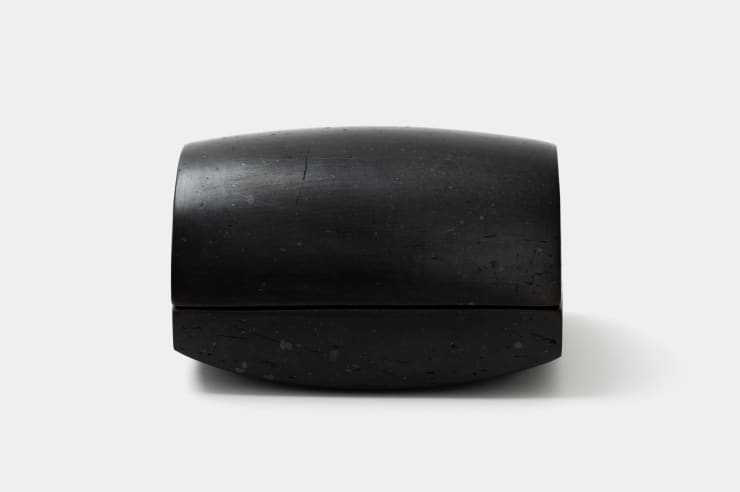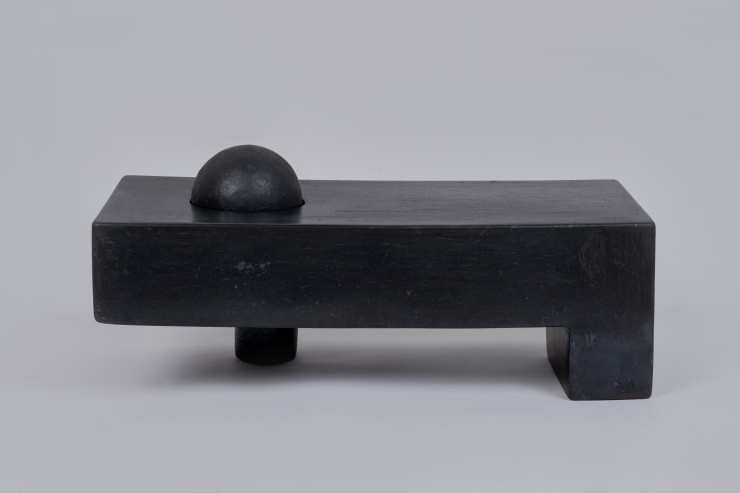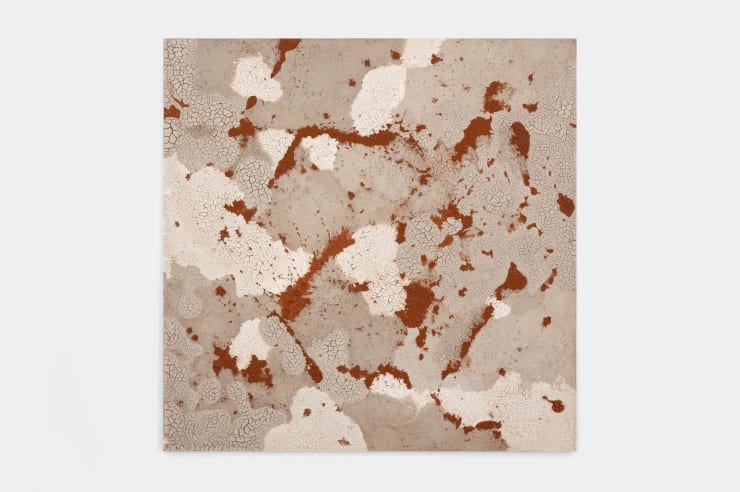Rando Aso
Rando Aso (born 1983, Nara, Japan) is a contemporary ceramic artist whose practice bridges ancient Japanese firing techniques with modern aesthetic sensibilities. Based in Minokamo, Japan, Aso is celebrated for his innovative approach to ceramics, emphasizing the primal relationship between clay and fire. His work explores the unpredictability of natural processes, resulting in tactile, unglazed earthenware pieces that bear the marks of fire, smoke, and earth.
Aso studied ceramics at Kanazawa College of Art, where he honed his understanding of clay's expressive potential. After graduating, he settled in Tokoname, Aichi Prefecture-one of Japan's oldest ceramic centers-before relocating to Minokamo. His technique draws inspiration from the Jomon period (2,500-1,500 BC), employing open-field firing methods such as "Noyaki," where clay is fired in burning grass, branches, and wood. This process, along with his "Kokutou" method-firing in a kiln followed by smoking in rice husks-produces distinctive color variations in yellow, red, black, and smoky hues. Aso's philosophy embraces the whimsical and uncontrollable nature of these techniques, selecting only the finest pieces from numerous firings.
Aso's work is deeply conceptual, focusing on the aesthetic over practicality. His signature sphere-shaped ceramics, often dented to release air and preserve form, reflect his interest in imprinting identity onto his creations, akin to an artist's stamp. His pieces, described as delicate yet robust, invite viewers to engage with their tactile surfaces and organic forms. Aso finds satisfaction in the versatility others discover in his work, despite its non-utilitarian focus.
Aso has exhibited widely, including at the prestigious Echigo-Tsumari Art Triennial (2015), Nonaka-Hill Gallery in Los Angeles, and in collaboration with Barbati Gallery in Venice (2024). His ceramics are featured in collections and galleries worldwide, such as Roman and Williams Guild in New York and Marc Selwyn Fine Art in Los Angeles. Through his practice, Aso continues to explore the infinite possibilities of clay, fire, and the dialogue between tradition and contemporaneity.
-
 Rando AsoIntimate Space, 2025Ceramic14 1/8 x 23 5/8 x 16 7/8 in
Rando AsoIntimate Space, 2025Ceramic14 1/8 x 23 5/8 x 16 7/8 in
36 x 60 x 43 cm -
 Rando AsoIntimate Space, 2025Ceramic3 x 7 5/8 x 7 5/8 in
Rando AsoIntimate Space, 2025Ceramic3 x 7 5/8 x 7 5/8 in
7.5 x 19.5 x 19.5 cm -
 Rando AsoIntimate Space, 2025Ceramic3 x 7 7/8 x 7 7/8 in
Rando AsoIntimate Space, 2025Ceramic3 x 7 7/8 x 7 7/8 in
7.5 x 20 x 20 cm -
 Rando AsoIntimate Space, 2025Ceramic4 3/8 x 7 1/8 x 4 7/8 in
Rando AsoIntimate Space, 2025Ceramic4 3/8 x 7 1/8 x 4 7/8 in
11 x 18 x 12.5 cm -
 Rando AsoIntimate Space, 2025Ceramic4 3/8 x 7 1/8 x 4 7/8 in
Rando AsoIntimate Space, 2025Ceramic4 3/8 x 7 1/8 x 4 7/8 in
11 x 18 x 12.5 cm -
 Rando AsoSphere and Space, 2025CeramicTwo parts;
Rando AsoSphere and Space, 2025CeramicTwo parts;
29 3/4 x 11 3/8 x 14 in (75.5 x 29 x 35.5 cm)
Dimensions variable -
 Rando AsoSphere and Space, 2025CeramicTwo parts;
Rando AsoSphere and Space, 2025CeramicTwo parts;
27 3/4 x 19 3/4 x 15 3/8 in (70.5 x 50 x 39 cm)
Dimensions variable -
 Rando AsoIntimate Space, 2024CeramicTwo parts; 4 7/8 x 11 3/8 x 4 3/4 in installed
Rando AsoIntimate Space, 2024CeramicTwo parts; 4 7/8 x 11 3/8 x 4 3/4 in installed
12.5 x 29 x 12 cm installed -
 Rando AsoVestige, 2024Ceramic45 1/4 x 45 1/4 x 1 1/8 in
Rando AsoVestige, 2024Ceramic45 1/4 x 45 1/4 x 1 1/8 in
115 x 115 x 3 cm -
 Rando AsoSphere and Space, 2024Ceramic7 7/8 x 17 1/2 x 6 1/2 in
Rando AsoSphere and Space, 2024Ceramic7 7/8 x 17 1/2 x 6 1/2 in
20 x 44.5 x 16.5 cm
Diameter of the sphere: 4 in (10.5 cm) -
 Rando AsoLandscape of Stone and Mountain, 2024Ceramic and stoneTwo parts; 9 7/8 x 19 1/4 x 18 1/2 in installed
Rando AsoLandscape of Stone and Mountain, 2024Ceramic and stoneTwo parts; 9 7/8 x 19 1/4 x 18 1/2 in installed
25 x 49 x 47 cm installed -
 Rando AsoJewel, 2024Ceramic and stoneTwo parts; 5 1/2 x 22 x 16 1/2 in installed
Rando AsoJewel, 2024Ceramic and stoneTwo parts; 5 1/2 x 22 x 16 1/2 in installed
14 x 56 x 42 cm installed -
 Rando AsoBOX / 匣 , 2023CeramicTwo parts;
Rando AsoBOX / 匣 , 2023CeramicTwo parts;
7 1/2 x 7 7/8 x 7 7/8 in overall
19 x 20 x 20 cm overall -
 Rando AsoBOX / 匣 , 2023CeramicTwo parts;
Rando AsoBOX / 匣 , 2023CeramicTwo parts;
5 1/4 x 6 7/8 x 5 1/4 in overall
13.5 x 17.5 x 13.5 cm overall -
 Rando AsoSphere and Space / 場, 2023CeramicTwo parts;
Rando AsoSphere and Space / 場, 2023CeramicTwo parts;
6 1/8 x 18 1/2 x 8 1/2 in (15.5 x 47 x 21.5 cm)
Sphere: 4 x 4 x 4 in (10 x 10 x 10 cm)
Installed dimensions variable -
 Rando AsoLight in Shade, 2023Ceramic71 1/4 x 71 1/4 in
Rando AsoLight in Shade, 2023Ceramic71 1/4 x 71 1/4 in
181 x 181 cm -
 Rando AsoSphere and Space, 2023CeramicTwo parts; 7 1/2 x 5 1/2 x 11 3/8 in installed
Rando AsoSphere and Space, 2023CeramicTwo parts; 7 1/2 x 5 1/2 x 11 3/8 in installed
19 x 14 x 29 cm installed -
 Rando AsoHollow Shape (cuboid) / 中空のかたち, 2022Ceramic4 1/8 x 18 3/4 x 4 7/8 in
Rando AsoHollow Shape (cuboid) / 中空のかたち, 2022Ceramic4 1/8 x 18 3/4 x 4 7/8 in
10.5 x 47.5 x 12.5 cm -
 Rando AsoHollow Shape (baguette) / 中空のかたち, 2021Ceramic7 1/8 x 24 3/8 x 7 1/8 in
Rando AsoHollow Shape (baguette) / 中空のかたち, 2021Ceramic7 1/8 x 24 3/8 x 7 1/8 in
18 x 62 x 18 cm -
 Rando AsoTrace, 2018Ceramic60 5/8 x 60 5/8 in
Rando AsoTrace, 2018Ceramic60 5/8 x 60 5/8 in
154 x 154 cm -
 Rando AsoOn Painting II, 2018Clay, red iron dioxide60 5/8 x 60 5/8 in
Rando AsoOn Painting II, 2018Clay, red iron dioxide60 5/8 x 60 5/8 in
154 x 154 cm
-

Rando Aso: Innerspace
September 13 - October 30, 2025 Los AngelesNonaka Hill is delighted to present Innerspace , a solo exhibition of ceramics by Rando Aso. In his first presentation in the United States, Aso focuses on his signature unglazed...Read more -

an arena
In collaboration with Barbati Gallery, Venice April 17 - June 20, 2024 OtherNonaka-Hill is pleased to announce the opening of an arena , a group exhibition presented in collaboration with Barbati Gallery, Venice Italy. an arena opens Wednesday, April 17, 2024 from...Read more
























